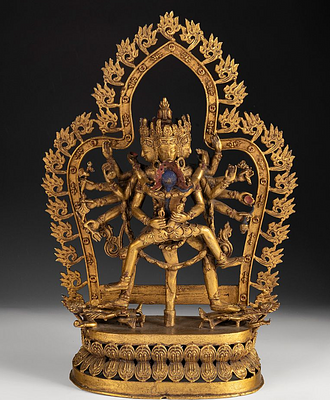Three deities. China, 20th century. Coral. Wooden base.
Lot 102
About Seller
Setdart Auction House
Carrer Aragó 346
Barcelona
Spain
Setdart Subastas was born in 2004 and is currently the first online art auction in Spain with solidity, prestige and reliability guaranteed by our more than 60,000 users. Setdart has a young, dynamic and enterprising team ready to successfully manage the purchase and sale of art works through custom...Read more
Categories
Estimate:
EUR€5,000 - EUR€5,500
$5,376.34 - $5,913.98
Absentee vs Live bid
Two ways to bid:
- Leave a max absentee bid and the platform will bid on your behalf up to your maximum bid during the live auction.
- Bid live during the auction and your bids will be submitted real-time to the auctioneer.
Bid Increments
| Price | Bid Increment |
|---|---|
| EUR€0 | EUR€10 |
| EUR€200 | EUR€25 |
| EUR€500 | EUR€50 |
| EUR€1,000 | EUR€100 |
| EUR€3,000 | EUR€200 |
| EUR€5,000 | EUR€500 |
| EUR€10,000 | EUR€1,000 |
| EUR€20,000 | EUR€2,000 |
| EUR€50,000 | EUR€5,000 |
About Auction
By Setdart Auction House
Jun 16, 2021
Set Reminder
2021-06-16 06:15:00
2021-06-16 06:15:00
America/New_York
Bidsquare
Bidsquare : Oriental Art Collection
https://www.bidsquare.com/auctions/setdart-auction-house/oriental-art-collection-7080
Setdart Auction House sofia@setdart.com
Setdart Auction House sofia@setdart.com
- Lot Description
Three deities. China, 20th century. Coral. Wooden base. Weight: 492 gr. (figure). Measurements: 16.5 x 15.5 x 7.5 cm (without base); 15.5 x 21 x 8.5 cm (with base). This sculptural group, entirely made of coral, shows three Chinese deities. Judging by their attributes, we would find ourselves in front of the representation of Hotei or "Buddha of happiness", characterized by his wide belly; Ebisu, protector of fishermen, characterized by the fish hanging from his staff, and a third unidentified deity, with a long beard and long lobes. The meticulous work of the carving, of laborious detail in each of its parts, denotes the technical skill of the artisan. Among the most beautiful products that the sea offers to the vanity of humans is, without a doubt, red coral, which in all times has served as a precious adornment with which many peoples have adorned and ornamented themselves. In some Eastern cultures, red coral is not only a highly esteemed adornment, but also a sign of dignity or command: the mandarins of China wore it as an attribute of their authority. The Turks were also very fond of coral ornaments, which they wore not only on their person, but also in the decoration and ornamentation of their homes. The Greeks designated coral by the name of korallion, which means "ornament of the sea", this word passed into Latin as corallium, from which the word coral was derived. The color of the limestone shaft offers a great variety of shades ranging from red to pink and some of these colorations have a delicate and soft pink hue, the most sought after by divers. The limestone shaft is so compact and homogeneous that it can be subjected to the most perfect polishing without disintegration and cracking, a property that allows it to be worked and carved in a thousand different ways to achieve an infinite number of decorative or artistic objects.
- Shipping Info
-
In-house shipping available. Please inquire at admin@setdart.com.
-
- Buyer's Premium



 EUR
EUR CAD
CAD AUD
AUD GBP
GBP MXN
MXN HKD
HKD CNY
CNY MYR
MYR SEK
SEK SGD
SGD CHF
CHF THB
THB














